Beta Sagittae

| |
| Observation data Epoch J2000.0 Equinox J2000.0 (ICRS) | |
|---|---|
| Constellation | Sagitta |
| Right ascension | 19h 41m 02.9393s[1] |
| Declination | +17° 28′ 33.748″[1] |
| Apparent magnitude (V) | 4.387[1] |
| Characteristics | |
| Spectral type | G8IIIa[1] |
| U−B color index | +0.89[2] |
| B−V color index | +1.05[2] |
| R−I color index | +0.50[2] |
| Astrometry | |
| Radial velocity (Rv) | −22.4 ± 0.9[1] km/s |
| Proper motion (μ) | RA: 9.06[1] mas/yr Dec.: −33.90[1] mas/yr |
| Parallax (π) | 7.42 ± 0.26[3] mas |
| Distance | 440 ± 20 ly (135 ± 5 pc) |
| Absolute magnitude (MV) | −1.39+0.22 −0.20[4] |
| Details | |
| Radius | 10[5] R☉ |
| Surface gravity (log g) | 2.79[4] cgs |
| Temperature | 4,850[4] K |
| Metallicity [Fe/H] | –0.03[4] dex |
| Rotational velocity (v sin i) | 9.1±0.7[4] km/s |
| Other designations | |
| Database references | |
| SIMBAD | data |
Beta Sagittae (Beta Sge, β Sagittae, β Sge) is a G-type giant star in the constellation of Sagitta.[1] It has an apparent visual magnitude of approximately 4.387.[1]
Naming
In Chinese, 左旗 (Zuǒ Qí), meaning Left Flag, refers to an asterism consisting of β Sagittae, α Sagittae, δ Sagittae, ζ Sagittae, γ Sagittae, 13 Sagittae, 11 Sagittae, 14 Sagittae and ρ Aquilae. Consequently, β Sagittae itself is known as 左旗二 (Zuǒ Qí èr, English: the Second Star of Left Flag.)[6]
References
- 1 2 3 4 5 6 7 8 9 10 * bet Sge -- Star, database entry, SIMBAD. Accessed on line October 13, 2010.
- 1 2 3 HR 7488, database entry, The Bright Star Catalogue, 5th Revised Ed. (Preliminary Version), D. Hoffleit and W. H. Warren, Jr., CDS ID V/50. Accessed on line October 13, 2010.
- ↑ van Leeuwen, F. (2007). "Validation of the New Hipparcos Reduction". Astronomy and Astrophysics 474 (2): 653–64. arXiv:0708.1752. Bibcode:2007A&A...474..653V. doi:10.1051/0004-6361:20078357.
- 1 2 3 4 5 Carney, Bruce W.; et al. (March 2008), "Rotation and Macroturbulence in Metal-Poor Field Red Giant and Red Horizontal Branch Stars", The Astronomical Journal 135 (3): 892–906, arXiv:0711.4984, Bibcode:2008AJ....135..892C, doi:10.1088/0004-6256/135/3/892
- ↑ HD 185958, database entry, Catalog of Apparent Diameters and Absolute Radii of Stars (CADARS), 3rd edition, L. E. Pasinetti-Fracassini, L. Pastori, S. Covino, and A. Pozzi, CDS ID II/224. Accessed on line October 13, 2010.
- ↑ (Chinese) AEEA (Activities of Exhibition and Education in Astronomy) 天文教育資訊網 2006 年 7 月 3 日
| ||||||||||||||||||||||||||||||
This article is issued from Wikipedia - version of the Friday, May 22, 2015. The text is available under the Creative Commons Attribution/Share Alike but additional terms may apply for the media files.